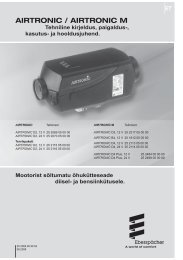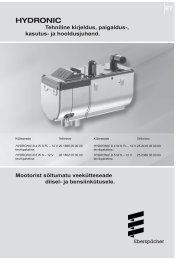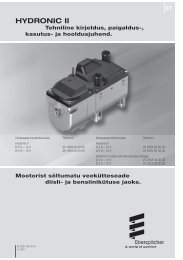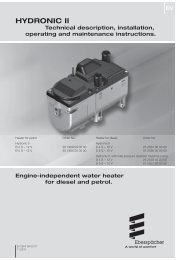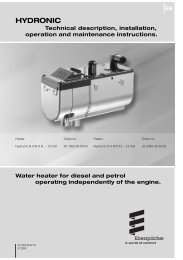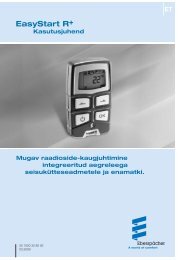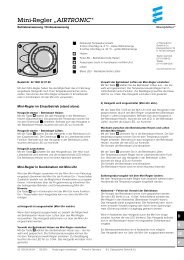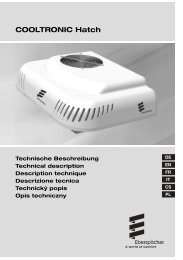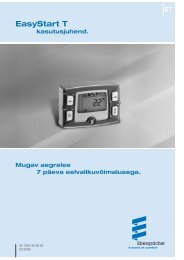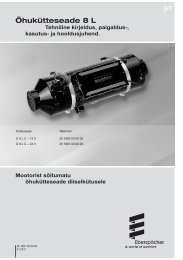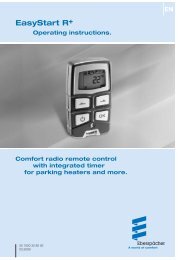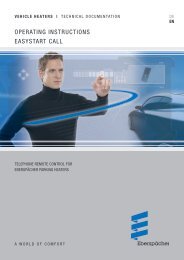Aufrüstung derHYDRONIC II - H im Toyota Avensis D - 4D ... - SoeAuto
Aufrüstung derHYDRONIC II - H im Toyota Avensis D - 4D ... - SoeAuto
Aufrüstung derHYDRONIC II - H im Toyota Avensis D - 4D ... - SoeAuto
Erfolgreiche ePaper selbst erstellen
Machen Sie aus Ihren PDF Publikationen ein blätterbares Flipbook mit unserer einzigartigen Google optimierten e-Paper Software.
Einbauvorschlag<br />
<strong>Aufrüstung</strong> der HYDRONIC <strong>II</strong> - H <strong>im</strong> <strong>Toyota</strong> <strong>Avensis</strong> D - <strong>4D</strong><br />
Modelljahr 2003<br />
2,0 l Hubraum / 85 KW / 4-Zyl.-Reihenmotor<br />
• mit manueller Kl<strong>im</strong>aanlage<br />
• mit Kl<strong>im</strong>aautomatik<br />
1<br />
24 0240 90 97 96 11.2004 Änderungen vorbehalten Printed in Germany © J. Eberspächer<br />
Eberspächer<br />
J. Eberspächer<br />
GmbH & Co. KG<br />
Eberspächerstr. 24<br />
D - 73730 Esslingen<br />
Service-Hotline<br />
01805 - 26 26 26<br />
Telefax<br />
01805 - 26 26 24<br />
Teile <strong>im</strong> Fahrzeug eingebaut:<br />
1 HYDRONIC <strong>II</strong>-H<br />
2 Dosierpumpe<br />
www.eberspaecher.com<br />
Mit dem Rüstsatz - Bestell Nr.<br />
24 0240 00 00 00 kann die<br />
HYDRONIC <strong>II</strong>-H <strong>im</strong> <strong>Toyota</strong> <strong>Avensis</strong><br />
zur Standheizung aufgerüstet werden.<br />
Bei Fahrzeugen mit Kl<strong>im</strong>aautomatik<br />
ist zusätzlich der Rüstsatz - Bestell Nr.<br />
24 0245 00 00 erforderlich.<br />
3 Abgasrohr mit Abgasschalldämpfer<br />
Teile aus dem Rüstsatz:<br />
4 Verbrennungsluftschalldämpfer<br />
5 Wasserpumpe<br />
6 Steuergerät<br />
7 Sicherungshalter<br />
8 Mini-Uhr<br />
D<br />
GB
D<br />
GB<br />
1 Einleitung<br />
Inhaltsverzeichnis<br />
Kapitel Kapitelbezeichnung Kapitelinhalt Seite<br />
1<br />
2<br />
3<br />
4<br />
Einleitung Inhaltverzeichnis -------------------------------------------------------------------------- 2<br />
Vorwort --------------------------------------------------------------------------------------- 3<br />
Unfallverhütung --------------------------------------------------------------------------- 3<br />
Gültigkeit-Einbauvorschlag ------------------------------------------------------------ 3<br />
Erforderliches Spezialwerkzeug ------------------------------------------------------ 4<br />
Anzugsdrehmomente -------------------------------------------------------------------- 4<br />
Zum Einbau notwendige Teile -------------------------------------------------------- 4<br />
Einbau Vorbereitung am Fahrzeug ------------------------------------------------------------- 5<br />
Wasserschlauch kürzen und Wasserpumpe montieren ----------------------- 5<br />
Verbrennungsluftschalldämpfer montieren ---------------------------------------- 6<br />
Steuergerät montieren ------------------------------------------------------------------- 6<br />
Kabelstränge vom Steuergerät verlegen ------------------------------------------ 6<br />
Adapter-Kabelstrang und Kabelstrang „Wasserpumpe“ anschließen ---- 6<br />
Sicherungshalter montieren ----------------------------------------------------------- 7<br />
Pluskabel anschließen------------------------------------------------------------------- 7<br />
Gebläseansteuerung bei Fahrzeugen mit manueller<br />
Kl<strong>im</strong>aanlage -------------------------------------------------------------------------------- 8<br />
Mini-Uhr montieren ----------------------------------------------------------------------- 8<br />
Nach der Montage Nach der Montage ----------------------------------------------------------------------- 9<br />
Schaltplan Schaltplan - <strong>Aufrüstung</strong> der HYDRONIC <strong>II</strong>-H<br />
in Fahrzeugen mit manueller Kliamanlage --------------------------------- 10, 11<br />
Schaltplan - <strong>Aufrüstung</strong> der HYDRONIC <strong>II</strong>-H<br />
in Fahrzeugen mit Kl<strong>im</strong>aanlage ------------------------------------------------ 12, 13<br />
2
1 Einleitung<br />
Vorwort<br />
Dieser Einbauvorschlag ist für das auf der Titelseite<br />
beschriebene Fahrzeug unter Ausschluss irgendwelcher<br />
Haftungsansprüche gültig.<br />
Je nach Ausführung bzw. Änderungszustand des<br />
Fahrzeuges können sich Abweichungen gegenüber<br />
diesem Einbauvorschlag ergeben.<br />
Der Einbauer hat dies vor dem Einbau zu prüfen und<br />
gegebenenfalls die Abweichungen gegenüber diesem<br />
Einbauvorschlag zu berücksichtigen<br />
!<br />
Achtung!<br />
Sicherheitshinweise für den Einbau und die Reparatur!<br />
Ein unsachgemäßer Einbau oder eine unsachgemäße<br />
Reparatur von Eberspächer-Heizgeräten kann einen<br />
Brand verursachen oder zum Eintritt giftiger Abgase in<br />
den Fahrzeuginnenraum führen.<br />
Hieraus kann eine Gefahr für Leib und Leben resultieren.<br />
Das Heizgerät darf nur von autorisierten und geschulten<br />
Personen entsprechend den Vorgaben in der technischen<br />
Dokumentation eingebaut und unter Verwendung von<br />
Original-Ersatzteilen repariert werden.<br />
Einbau und Reparaturen durch nicht autorisierte und<br />
ungeschulte Personen, Reparaturen mit nicht Original-<br />
Ersatzteilen, sowie ohne die zum Einbau bzw. Reparatur<br />
erforderliche, technische Dokumentation sind gefährlich<br />
und deshalb nicht zulässig.<br />
Bitte beachten!<br />
Ergänzend zu diesem Einbauvorschlag ist die Technische<br />
Beschreibung, Einbauanweisung, Bedienungsanweisung<br />
und Wartungsanweisung des Heizgerätes zu beachten,<br />
insbesondere die Sicherheitshinweise und die allgemeinen<br />
Hinweise.<br />
Die entsprechenden Regeln der Technik sowie<br />
eventuelle Angaben des Fahrzeugherstellers sind<br />
be<strong>im</strong> Einbau einzuhalten.<br />
Die Firma Eberspächer übern<strong>im</strong>mt keine Haftung für<br />
Mängel und Schäden, die auf einen Einbau durch nicht<br />
autorisierte und ungeschulte Personen zurückzuführen<br />
sind.<br />
Unfallverhütung<br />
Grundsätzlich sind die allgemeinen Unfallverhütungsvorschriften<br />
und die entsprechenden<br />
Werkstatt- und Betriebsschutzanweisungen zu<br />
beachten.<br />
3<br />
Gültigkeit - Einbauvorschlag<br />
Der Einbauvorschlag ist für die Fahrzeuge mit den<br />
nachfolgend aufgelisteten Motor- und Getriebevarianten<br />
gültig.<br />
Motor- und Getriebevarianten<br />
Hubraum kW / PS Getriebe<br />
2,0 l 85 / 116 5S<br />
5S = 5-Gang Schaltgetriebe<br />
Bitte beachten!<br />
Fahrzeugtypen, Motorentypen und Ausstattungsvarianten,<br />
die nicht in diesem Einbauvorschlag aufgeführt sind,<br />
wurden nicht geprüft.<br />
Der Einbau nach diesem Einbauvorschlag kann aber<br />
möglich sein.<br />
D<br />
GB
D<br />
GB<br />
1 Einleitung<br />
Erforderliches Spezialwerkzeug<br />
Drehmomentschlüssel (5....50 Nm)<br />
Abklemmzangen (Kühlwasserschläuche)<br />
Schlüssel für Klemmring der Tankarmatur<br />
Zange für Federbandschellen<br />
Rostschutzgrundierung<br />
Blindnietmutternzange<br />
Zum Einbau notwendige Teile<br />
Stückzahl / Benennung Bestell Nr.<br />
1 Rüstsatz für<br />
HYDRONIC <strong>II</strong>-H 24 0240 00 00 00<br />
Im Rüstsatz ist enthalten:<br />
1 Bedienelement<br />
- Teile für das Heizgerät<br />
- Teile für den Wasserkreislauf<br />
- Teile für die Elektrik<br />
Bei Fahrzeugen mit Kl<strong>im</strong>aautomatik zusätzlich<br />
bestellen<br />
Stückzahl / Benennung Bestell Nr.<br />
1 Rüstsatz Kl<strong>im</strong>aautomatik 24 0245 00 00 00<br />
4<br />
Anzugsdrehmomente<br />
Wenn keine Anzugsdrehmomente vorgegeben sind,<br />
dann die Schraubverbindungen (Skt.- Schraube und<br />
Skt.-Muttern) entsprechend folgender Tabelle anziehen.<br />
Schraubverbindungen Anzugsdrehmoment<br />
M 6 10 Nm<br />
M 8 20 Nm<br />
M 10 45 Nm
2 Einbau<br />
Vorbereitungen am Fahrzeug<br />
Batterie abklemmen<br />
Beide Motorabdeckungen abbauen<br />
Luftfilter abbauen<br />
Druck <strong>im</strong> Kühlsystem ablassen<br />
Kühlmittel ablassen<br />
Kraftstofffilter abbauen<br />
Wasserschlauch kürzen und Wasserpumpe montieren<br />
(siehe Skizze1, Bild 1 und Bild 2)<br />
Den Schlauchwinkel vom Wassereintrittsstutzen des<br />
Heizgerätes abziehen und - wie in der Skizze gezeigt -<br />
kürzen.<br />
Anschließend vom abgetrennten Schlauchstück, ein<br />
kurzes Schlauchstück, ca. 50 mm lang abschneiden.<br />
Das kurze Schlauchstück amWassereintrittsstutzen der<br />
Wasserpumpe uns am Wassereintrittsstutzen des<br />
Heizgerätes anschließen und mit Schlauchschellen<br />
sichern.<br />
Den gekürzten Schlauchwinkel am Wasseraustrittsstutzen<br />
der Wasserpumpe anschließen und mit einer Schlauchschelle<br />
sichern.<br />
Die Wasserpumpe mit einem Kabelband am vorhandenen<br />
Wasserschlauch (mit Schutzschlauch) befestigen.<br />
Bitte beachten!<br />
Bei der Montage der Wasserpumpe unbedingt auf<br />
genügend Abstand zum Schaltgestänge achten.<br />
Wasserschläuche vor dem endgültigen Anschließen<br />
mit Kühlflüssigkeit befüllen.<br />
Bild 1<br />
�����<br />
� Heizgerät<br />
� Wasserpumpe<br />
� Schlauchwinkel<br />
�����<br />
�����<br />
5<br />
Skizze 1<br />
Bild 2<br />
� Heizgerät<br />
� Wasserpumpe<br />
� Schaltgestänge<br />
�����<br />
�����<br />
�����<br />
D<br />
GB
D<br />
GB<br />
2 Einbau<br />
Verbrennungsluftschalldämpfer montieren<br />
Das Verbrennungluftansaugrohr am Heizgerät abbauen<br />
und durch den Verbrennungsluftschalldämpfer ersetzen.<br />
Den Verbrennungsluftansaugschalldämpfer an geeigneten<br />
Stellen <strong>im</strong> Motorraum mit Kabelbänder befestigen.<br />
Steuergerät montieren (siehe Bild 3)<br />
Den Halter an der Motortrennwand, unterhalb der eingeprägten<br />
Fahrgestellnummer anlegen und zwei<br />
Befestigungsbohrungen, ø 9 mm markieren und bohren.<br />
In beide Befestigungsbohrungen, ø 9 mm je eine Einziehmuttern,<br />
M 6 einsetzen.<br />
Das Steuergerät am Halter befestigen.<br />
Anschließend den Halter mit dem montierten Steuergerät<br />
an der Motortrennwand mit zwei Skt.-Schrauben, M6<br />
und 2 Federscheiben B 56 an der Motortrennwand<br />
befestigen.<br />
Kabelstränge vom Steuergerät verlegen (siehe Bild 4)<br />
Den Adapter-Kabelstrang und den Kabelstrang „Wasserpumpe“<br />
nach links zum Heizgerät verlegen.<br />
Den Kabelstrang „Bedienung“ und den Kabelstrang<br />
„Gebläseansteuerung“ auf die rechte Fahrzeugseite,<br />
durch die vorhandenen Tülle in der Motortrennwand in<br />
den Fahrzeuginnenraum verlegen.<br />
Das Pluskabel zur Batterie verlegen.<br />
Adapter-Kabelstrang und Kabelstrang „Wasserpumpe“<br />
anschließen<br />
Die serienmäßige Steckverbindung <strong>im</strong> Bereich des<br />
Heizgerätes trennen und den Adapter-Kabelstrang<br />
anschließen.<br />
Am Kabelstrang „Wasserpumpe“ die 2-polige Kupplung,<br />
mit Steckhülsen und Dichtungen anschließen.<br />
Die 2-polige Kupplung an der Wasserpumpe einclipsen.<br />
6<br />
Bild 3<br />
�����<br />
� Halter für Steuergerät<br />
� Steuergerät<br />
Bild 4<br />
�����<br />
�����<br />
� Kabelstrang „Bedienung“ und den Kabelstrang<br />
„Gebläseansteuerung“<br />
� Tülle in der Motortrennwand<br />
�����
2 Einbau<br />
Sicherungshalter montieren (siehe Bild 5)<br />
Den Halter für den Sicherungshalter neben der Batterie<br />
am vorhandenen Stehbolzen <strong>im</strong> Radlauf befestigen.<br />
Das Pluskabel zum Sicherungshalter verlegen und entsprechend<br />
ablängen.<br />
Das Pluskabel am Sicherungshalter anschließen.<br />
Die Sicherung in den Sicherungshalter einsetzen.<br />
Bild 5<br />
� Halter für den Sicherungshalter<br />
Pluskabel anschließen (siehe Bild 7)<br />
Das restliche Pluskabel vom Sicherungshalter zum<br />
Batterie-Pluspol verlegen und anschließen.<br />
Bitte beachten!<br />
����� �����<br />
Die Kabelstränge an geeigneten Stellen<strong>im</strong> Motorraum mit<br />
Kabelbändern befestigen, hierbei auf scharfe Kanten<br />
achten, wenn erforderlich einen Kantenschutz anbringen.<br />
Bei der Verlegung der Kabelstränge unbedingt auf<br />
genügend Abstand zu heißen Fahrzeugteilen achten.<br />
7<br />
Bild 6<br />
� Sicherungshalter<br />
Bild 7<br />
�����<br />
� Pluskabel am Batterie-Pluspol angeschlossen<br />
D<br />
GB
D<br />
GB<br />
2 Einbau<br />
Gebläseansteuerung bei Fahrzeugen mit manueller<br />
Kl<strong>im</strong>aanlage (siehe Bild 8)<br />
Den Kabelstrang „Gebläseansteuerung“ <strong>im</strong> Armaturenbrett<br />
zum Gebläsemotor verlegen.<br />
Die Stromversorgung des Gebläses erfolgt direkt am<br />
Gebläsemotor durch Einbindung von Kabel 4 2 sw und<br />
Kabel 4 2 sw/vi in das Kabel 4 2 bl/sw.<br />
Zusätzlich bei Fahrzeugen mit Kl<strong>im</strong>aautomatik<br />
Bei Fahrzeugen mit Kl<strong>im</strong>aautomatik muss zusätzlich<br />
ein Relais eingebaut werden.<br />
Verdrahtung siehe <strong>im</strong> Schaltplan auf Seite 12 und 13.<br />
Bitte beachten!<br />
Bei der Verdrahtung den Schaltplan beachten.<br />
Mini-Uhr montieren (siehe Bild 9)<br />
Die Bohrschablone an der linken Verkleidung der Mittelkonsole<br />
ankleben.<br />
Beide Befestigungsbohrungen, ø 2,5 mm und<br />
ø 7,5 mm bohren.<br />
Den Kabelstrang „Bedienung“ zum Einbauplatz der<br />
Mini-Uhr verlegen.<br />
Den Kabelstrang „Bedienung“ an der Mini-Uhr<br />
anschließen.<br />
Die Mini-Uhr an an der linken Verkleidung der<br />
Mittelkonsole befestigen.<br />
Bitte beachten!<br />
Bei der Montage der Mini-Uhr nicht auf das<br />
LCD-Display drücken.<br />
8<br />
Bild 8<br />
� Kabel 4 2 sw<br />
� Kabel 4 2 sw/vi<br />
� Kabel 4 2 bl/sw.<br />
Bild 9<br />
� Mini-Uhr<br />
�����<br />
�����<br />
�����<br />
�����<br />
�����
3 Nach der Montage<br />
Batterie anschließen.<br />
Alle abgebauten Teile wieder montieren.<br />
Alle Schlauchleitungen, Rohrschellen sowie alle elektrische<br />
Anschlüsse auf festen Sitz prüfen.<br />
Das Kühlwassersystems entlüften und auf Dichtheit prüfen.<br />
Bitte beachten Sie auch die Angaben des Fahrzeugherstellers<br />
zur Befüllung und Entlüftung des Kühlwassersystems.<br />
Mini-Uhr programmieren und die Bedienungsanweisung<br />
der Mini-Uhr in das Handschuhfach legen.<br />
Alle lose Leitungen mit Kabelbändern sichern.<br />
Behördliche Vorschriften und Sicherheitshinweise in<br />
der Technischen Beschreibung beachten.<br />
9<br />
D<br />
GB
D<br />
GB<br />
4 Schaltplan<br />
Schaltplan - <strong>Aufrüstung</strong> der HYDRONIC <strong>II</strong>-H in<br />
Fahrzeugen mit manueller Kl<strong>im</strong>aanlage<br />
10
4 Schaltplan<br />
24 0240 00 96 01<br />
11<br />
Teileliste<br />
1 Heizgerät<br />
1.1 Brennermotor<br />
1.2 Glühkerze<br />
1.5 Überhitzungsfühler<br />
1.12 Flammfühler<br />
1.13 Temperaturfühler<br />
2.1 Steuergerät<br />
2.2 Dosierpumpe<br />
2.7 Hauptsicherung, 25 A<br />
2.7.5 Sicherung-Fahrzeuggebläse, 25 A<br />
2.12 Wasserpumpe<br />
2.16 Steuergerät, Nachrüstung<br />
Zuheizer - Standheizung<br />
3.2.14 Mini-Uhr<br />
5.1 Batterie<br />
5.10 Fahrzeuggebläse<br />
a) Diagnose<br />
b) +15 Zündung<br />
c) D+ Lichtmaschine<br />
d) Ansteuerung Kl<strong>im</strong>aautomatik<br />
und / oder Diebstahlwarnanlage<br />
e) Leitung hier auftrennen<br />
Stecker und Leitungsenden sind von der<br />
Leitungseintrittsseite dargestellt.<br />
Unbenutzte Leitungsenden isolieren!<br />
D<br />
GB
D<br />
GB<br />
4 Schaltplan<br />
Schaltplan - <strong>Aufrüstung</strong> der HYDRONIC <strong>II</strong>-H in<br />
Fahrzeugen mit Kl<strong>im</strong>aautomatik<br />
12
4 Schaltplan<br />
24 0245 00 96 01<br />
13<br />
Teileliste<br />
1 Heizgerät<br />
1.1 Brennermotor<br />
1.2 Glühkerze<br />
1.5 Überhitzungsfühler<br />
1.12 Flammfühler<br />
1.13 Temperaturfühler<br />
2.1 Steuergerät<br />
2.2 Dosierpumpe<br />
2.7 Hauptsicherung, 25 A<br />
2.7.5 Sicherung-Fahrzeuggebläse, 25 A<br />
2.12 Wasserpumpe<br />
2.16 Steuergerät, Nachrüstung<br />
Zuheizer - Standheizung<br />
3.2.14 Mini-Uhr<br />
5.1 Batterie<br />
5.10 Fahrzeuggebläse<br />
a) Diagnose<br />
b) +15 Zündung<br />
c) D+ Lichtmaschine<br />
d) Ansteuerung Kl<strong>im</strong>aautomatik<br />
und / oder Diebstahlwarnanlage<br />
e) Leitung hier auftrennen<br />
Stecker und Leitungsenden sind von der<br />
Leitungseintrittsseite dargestellt.<br />
Unbenutzte Leitungsenden isolieren!<br />
D<br />
GB
Suggested installation<br />
Upgrade of the HYDRONIC <strong>II</strong> H in the <strong>Toyota</strong> <strong>Avensis</strong> D-<strong>4D</strong><br />
Model year 2003<br />
2.0 L cc / 85 kW / 4-cylinder in-line engine<br />
• with manual air conditioning<br />
• with automatic air conditioning system<br />
15<br />
24 0240 90 97 96 11.2004 Subject to change without notice Printed in Germany © J. Eberspächer<br />
Eberspächer<br />
J. Eberspächer<br />
GmbH & Co. KG<br />
Eberspächerstr. 24<br />
D - 73730 Esslingen<br />
Service-Hotline<br />
01805 - 26 26 26<br />
Telefax<br />
01805 - 26 26 24<br />
Parts installed in the vehicle:<br />
1 HYDRONIC <strong>II</strong> H<br />
2 Metering pump<br />
www.eberspaecher.com<br />
The HYDRONIC <strong>II</strong> H in the <strong>Toyota</strong><br />
<strong>Avensis</strong> can be upgraded to auxiliary<br />
heater with kit order no. 24 0240 00 00<br />
00. In vehicles fitted with an automatic<br />
air-conditioning system, kit order no.<br />
24 0245 00 00 is also required.<br />
3 Exhaust pipe with exhaust silencer<br />
Parts from the kit:<br />
4 Combustion air silencer<br />
5 Water pump<br />
6 Control unit<br />
7 Fuse holder<br />
8 Mini-t<strong>im</strong>er<br />
D<br />
GB
D<br />
GB<br />
1 Introduction<br />
Table of Contents<br />
Chapter Title Content Page<br />
1<br />
2<br />
3<br />
4<br />
Introduction Table of Contents ------------------------------------------------------------------------- 2<br />
Foreword ------------------------------------------------------------------------------------ 3<br />
Accident prevention --------------------------------------------------------------------- 3<br />
Validity, suggested installation ------------------------------------------------------- 3<br />
Special tools required ------------------------------------------------------------------- 4<br />
Tightening torques ----------------------------------------------------------------------- 4<br />
Parts required for installation ---------------------------------------------------------- 4<br />
Installation Preparations on the vehicle ------------------------------------------------------------ 5<br />
Shorten water hose and install water pump --------------------------------------- 5<br />
Fit combustion air silencer ------------------------------------------------------------- 6<br />
Fit control unit ------------------------------------------------------------------------------ 6<br />
Run cable sections from the control unit ------------------------------------------- 6<br />
Connect adapter and “water pump” cable sections --------------------------- 6<br />
Fit fuse holder ------------------------------------------------------------------------------ 7<br />
Connect positive cable ------------------------------------------------------------------ 7<br />
Blower control in vehicles with manual air conditioning ----------------------- 8<br />
Install mini-t<strong>im</strong>er --------------------------------------------------------------------------- 8<br />
After installation After installation --------------------------------------------------------------------------- 9<br />
Wiring diagram Wiring diagram - upgrade of the HYDRONIC <strong>II</strong> H<br />
in vehicles with manual air conditioning ------------------------------------ 10, 11<br />
Wiring diagram - upgrade of the HYDRONIC <strong>II</strong> H<br />
in vehicles with air conditioning ----------------------------------------------- 12, 13<br />
16
1 Introduction<br />
Foreword<br />
This suggested installation applies to the vehicle on the<br />
title page; however, no liability is accepted for cla<strong>im</strong>s arising<br />
from this suggested installation.<br />
Depending on model and modification status of the vehicle,<br />
changes to this suggested installation may be necessary.<br />
The fitter must check this before installing the heater and if<br />
necessary take into account any discrepancies compared<br />
with this suggested installation.<br />
!<br />
Important!<br />
Safety instructions for installation and repair!<br />
Improper installation or repair of Eberspächer heaters<br />
could cause a fire or cause toxic exhaust gases to enter<br />
the vehicle interior.<br />
This could result in danger to life and l<strong>im</strong>b.<br />
The heater may only be installed by authorised, trained<br />
personnel in accordance with the requirements laid down<br />
in the technical documentation and may only be repaired<br />
using original spare parts.<br />
Installation and repair by unauthorised and untrained persons<br />
and repairs using non-original spare parts and without<br />
the technical documentation required for the installation<br />
or repair are dangerous and are therefore not permitted.<br />
Please note!<br />
The Technical Description, Installation Instructions, Operating<br />
Instructions and Maintenance Instructions for the<br />
heater, especially the safety instructions and general information,<br />
must also be complied with as well as this suggested<br />
installation.<br />
The relevant approved technical practice and any information<br />
provided by the vehicle manufacturer must be<br />
complied with during the installation.<br />
The Eberspächer company accepts no liability for defects<br />
and damage caused by installation by unauthorised and<br />
untrained persons.<br />
Accident prevention<br />
The general Accident Prevention Regulations and the corresponding<br />
plant and operational protective instructions<br />
must be observed.<br />
17<br />
Validity, suggested installation<br />
The suggested installation applies to vehicles with the<br />
following engine and transmission variants:<br />
Engine and transmission variants<br />
Cubic capacity kW / hp Gearbox<br />
2,0 l 85 / 116 5S<br />
5S = 5-speed gearbox<br />
Please note!<br />
Vehicle types, engine types and equipment variants that<br />
are not listed in this suggested installation have not been<br />
tested.<br />
However, installation as described in this suggested installation<br />
may be possible.<br />
D<br />
GB
D<br />
GB<br />
1 Introduction<br />
Special tools required<br />
Spanner torque wrench (5–50 Nm)<br />
Hose pinch-off pliers (cooling-water hoses)<br />
Key for tank fitting clamping ring<br />
Pliers for spring cable ties<br />
Anti-corrosive pr<strong>im</strong>er<br />
Blind rivet nut pliers<br />
Par Parts Par ts r rrequir<br />
rr<br />
equir equir equired equir ed for for installation<br />
installation<br />
Quantity / Designation Cat. No.<br />
1 kit for HYDRONIC <strong>II</strong>-H 24 0240 00 00 00<br />
Included in the kit:<br />
1 control element<br />
- Parts for the heater<br />
- Parts for the water circulation system<br />
- Parts for the electrical system<br />
Additionally to be ordered for vehicles with automatic air<br />
conditioning system:<br />
Quantity / Designation Cat. No.<br />
1 automatic air-conditioning system kit 24 0245 00 00 00<br />
18<br />
Tightening torques<br />
If no tightening torques have been prescribed, then<br />
tighten<br />
the bolted joints (hex. bolt and hexagon nuts) in accor<br />
dance with the table below.<br />
Bolted joints Tightening torque<br />
M 6 10 Nm<br />
M 8 20 Nm<br />
M 10 45 Nm
2 Installation<br />
Preparations on the vehicle<br />
Disconnect battery<br />
Remove both engine covers<br />
Remove air filter<br />
Release pressure in the cooling system<br />
Drain off coolant<br />
Remove fuel filter<br />
Shorten water hose and install water pump<br />
(see drawing 1, Figures 1 and 2)<br />
Pull the angled piece of hose out from the water inlet connecting<br />
piece of the heater and shorten, as shown in the<br />
diagram.<br />
Then cut a short piece of hose, approx. 50 mm long, from<br />
the piece of hose that you have cut off. Connect the short<br />
piece of hose to the water inlet connecting piece of the<br />
water pump around the water inlet connecting piece of the<br />
heater and secure with hose clips.<br />
Connect the shortened angled piece of hose to the water<br />
inlet connecting piece of the water pump and secure with<br />
a hose clip.<br />
Attach the water pump to the existing water hose<br />
(with protective hose) with a cable band.<br />
Please note!<br />
When installing the water pump, make sure you leave a<br />
sufficient gap from the gearshift linkage.<br />
Fill water hoses with coolant prior to final installation.<br />
Figure 1<br />
�����<br />
� Heater<br />
� Water pump<br />
� Angled piece of hose<br />
�����<br />
�����<br />
19<br />
Drawing 1<br />
Figure 2<br />
� Heater<br />
� Water pump<br />
� Gearshift linkage<br />
�����<br />
�����<br />
�����<br />
D<br />
GB
D<br />
GB<br />
2 Installation<br />
Fit combustion air silencer<br />
Remove the combustion air intake pipe on the heater and<br />
replace with the combustion air silencer. Attach combustion<br />
air silencer at suitable points in the engine compartment<br />
with cable bands.<br />
Fit control unit (see Figure 3)<br />
Place the holder on engine partition, below the <strong>im</strong>printed<br />
vehicle chassis number, mark two fastening holes 9 mm<br />
dia. and drill. Insert a tightening nut M6 in both 9 mm dia.<br />
fastening holes.<br />
Attach control unit to the holder.<br />
Then attach the holder with the installed control unit to the<br />
engine partition with two M6 hex. bolts and two B56 spring<br />
washers.<br />
Lay cable sections from control unit (see Figure 4)<br />
Run the adapter cable and “water pump” cable sections<br />
to the left up to the heater.<br />
Run the “operation” and “blower control” cable sections<br />
on the right-hand side of the vehicle, through the existing<br />
grommet in the engine partition into the vehicle interior.<br />
Run the positive cable to the battery.<br />
Connect adapter and “water pump” cable sections<br />
Detach the standard plug connection near the heater and<br />
connect the adapter cable section.<br />
On the “water pump” cable section, connect the 2-pin<br />
coupling, with socket connections and gaskets.<br />
Clip 2 two-pin coupling on the water pump.<br />
20<br />
Figure 3<br />
�����<br />
� Holder for control unit<br />
� Control unit<br />
Figure 4<br />
�����<br />
�����<br />
� “Operation” cable section and<br />
“blower control” cable sections<br />
� Grommet in the engine partition<br />
�����
2 Installation<br />
Fit fuse holder (see Figure 5)<br />
Attach the mounting bracket for the fuse holder next to the<br />
existing stud bolt in the wheel arch near the battery. Run<br />
the positive cable to the fuse holder and cut to length.<br />
Connect the positive cable to the fuse holder. Insert the<br />
fuse in the fuse holder.<br />
Figure 5<br />
� Mounting bracket for the fuse holder<br />
Connect positive cable (see Figure 7)<br />
����� �����<br />
Run the rest of the positive cable from the fuse holder to<br />
the positive pole of the battery and connect up.<br />
Please note!<br />
Attach the cable sections at suitable points in the engine<br />
compartment using cable bands. In so doing, look out for<br />
sharp edges, and if necessary use edge protection. When<br />
laying the cable sections, make sure you leave a sufficient<br />
gap between the cables and any hot parts of the vehicle.<br />
21<br />
Figure 6<br />
� Fuse holder<br />
Figure 7<br />
�����<br />
� Positive cable connected to the positive pole<br />
of the battery<br />
D<br />
GB
D<br />
GB<br />
2 Installation<br />
Blower control in vehicles fitted with a manual air conditioning<br />
system (see Figure 8)<br />
Run the “blower control” cable section in the instrument<br />
panel to the blower motor.<br />
Power is supplied to the blower by connecting black cable<br />
4 mm 2 and black/violet cable 4 mm 2 directly to blue/<br />
violet cable 4 mm 2 on the blower motor.<br />
Additionally, in vehicles with automatic airconditioning<br />
system<br />
In addition, in vehicles equipped with an automatic airconditioning<br />
system, a relay has to be installed.<br />
For wiring details, see wiring diagram on pages 12-13.<br />
Please note!<br />
Consult the wiring diagram during wiring.<br />
Install mini-t<strong>im</strong>er (see Figure 9)<br />
Stick the drilling template to the left-hand panel of the<br />
centre console.<br />
Drill two fastening holes, 2.5 mm dia. and 7.5 mm dia.<br />
Run the “operation” cable section to the installation position<br />
of the mini-t<strong>im</strong>er.<br />
Connect “operation” cable section to the mini-t<strong>im</strong>er.<br />
Attach the mini-t<strong>im</strong>er to the left-hand panel of the centre<br />
console.<br />
Please note!<br />
When installing the mini-t<strong>im</strong>er, do not exert any pressure<br />
on the LCD display.<br />
22<br />
Figure 8<br />
�����<br />
�����<br />
� Black cable 4 mm²<br />
� Black/violet cable 4 mm²<br />
� Blue/black cable 4 mm²<br />
Figure 9<br />
� Mini-t<strong>im</strong>er<br />
�����<br />
�����<br />
�����
3 After installation<br />
Connect battery.<br />
Re-install all dismantled parts.<br />
Check all hose lines, hose clips and all electrical connections<br />
to ensure that they are securely in position.<br />
Bleed the cooling water system and check for leak-tightness.<br />
Be sure to follow the vehicle manufacturer’s specification<br />
regarding the filling and bleeding of the cooling water system.<br />
Programme mini-t<strong>im</strong>er and place the operating instructions<br />
for the mini-t<strong>im</strong>er in the glove compartment.<br />
Secure all loose lines with cable bands.<br />
Take care to comply with official regulations and safety<br />
instructions in the Technical Description.<br />
23<br />
D<br />
GB
D<br />
GB<br />
4 Wiring diagram<br />
Wiring diagram - upgrade of the HYDRONIC <strong>II</strong> H in vehicles<br />
with manual air-conditioning<br />
24
4 Wiring diagram<br />
24 0240 00 96 01<br />
25<br />
Parts list<br />
1 Heater<br />
1.1 Burner motor<br />
1.2 Glow plug<br />
1.5 Safety thermal cutout sensor<br />
1.12 Flame sensor<br />
1.13 Temperature sensor<br />
2.1 Control unit<br />
2.2 Metering pump<br />
2.7 Main fuse, 25 A<br />
2.7.5 25A fuse for vehicle blower<br />
2.12 Water pump<br />
2.16 Control unit, upgrade add-heater<br />
to auxiliary heater<br />
3.2.14 Mini-t<strong>im</strong>er<br />
5.1 Battery<br />
5.10 Vehicle blower<br />
a) Diagnosis<br />
b) +15 ignition<br />
c) D+ alternator<br />
d) Controls for automatic air conditioning<br />
system and/or anti-theft warning system<br />
e) Split line here<br />
The plug connector and cable ends are<br />
shown as viewed from the cable entry side.<br />
Unused cable ends should be insulated.<br />
D<br />
GB
D<br />
GB<br />
4 Wiring diagram<br />
Wiring diagram - upgrade of the HYDRONIC <strong>II</strong> H in vehicles<br />
with automatic air conditioning system<br />
26
4 Wiring diagram<br />
24 0245 00 96 01<br />
27<br />
Parts list<br />
1 Heater<br />
1.1 Burner motor<br />
1.2 Glow plug<br />
1.5 Safety thermal cutout sensor<br />
1.12 Flame sensor<br />
1.13 Temperature sensor<br />
2.1 Control unit<br />
2.2 Metering pump<br />
2.7 Main fuse, 25 A<br />
2.7.5 25A fuse for vehicle blower<br />
2.12 Water pump<br />
2.16 Control unit, upgrade add-heater to<br />
auxiliary heater<br />
3.2.14 Mini-t<strong>im</strong>er<br />
5.1 Battery<br />
5.10 Vehicle blower<br />
a) Diagnosis<br />
b) +15 ignition<br />
c) D+ alternator<br />
d) Controls for automatic air conditioning<br />
system and/or anti-theft warning system<br />
e) Split line here<br />
The plug connector and cable ends are<br />
shown as viewed from the cable entry side.<br />
Unused cable ends should be insulated.<br />
D<br />
GB



